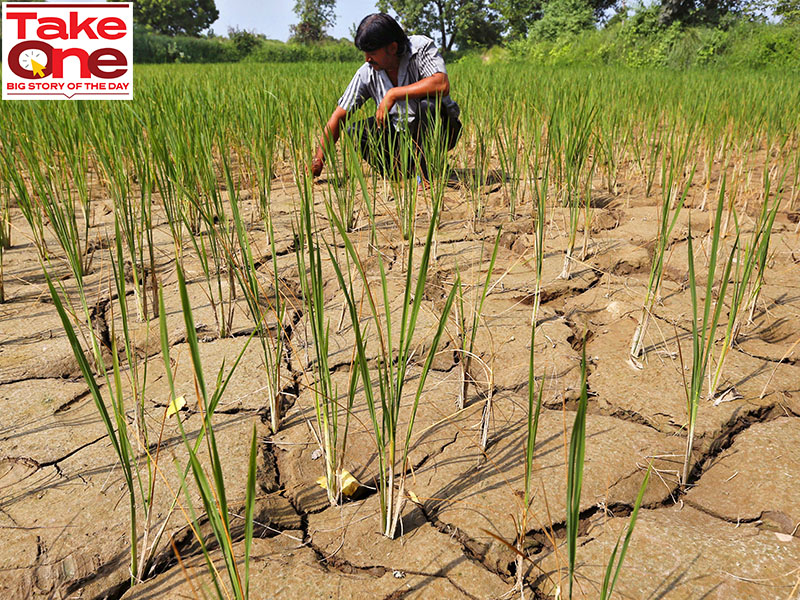
Image: Amit Dave / Reuteres
Early forecasts of a normal and above normal rainfall seem to have gone awry in June. The India Meteorological Department’s (IMD) and Skymet’s prediction for this year had fanned expectations of a strong rural recovery and some respite from rising food prices. However, the progress of monsoon has dashed hopes of abundant rainfall. June witnessed below normal rainfall, which was 17 percent below the long-term average (LTA).
Monsoon trackers also note a high spatial divergence: The northern and western regions of India witnessed a shortfall of 61 percent, central India a shortfall of 28 percent, east and northeastern regions saw 7 percent deficient rainfall; but the southern peninsula has received 10 percent surplus rains so far. IMD, however, stands by its forecast of above normal rainfall this calendar year, although it has downgraded its June forecast to ‘below normal’ from ‘normal’ rainfall due to slow progress of the monsoon.
Nearly 50 percent of India’s agricultural land depends solely on the monsoon for irrigation. A poor monsoon can lower agricultural output and stoke higher food prices and inflation.
Eye on the sky
The monsoon had a good start, but its pace has stalled over the past weeks. The pause in rains across most regions of the country has delayed sowing of kharif crops such as sugarcane, cotton, rice, cotton, and soybeans. “A significant delay in kharif sowing will impact food output, and the rabi sowing season as farmers will have less time to prepare their fields after the kharif harvest,” says Madhavi Arora, lead economist, Emkay Global Financial Services.
Ongoing heatwave conditions have aggravated supply-side challenges and put pressure on retail food prices. Economists note that average retail prices on an annual basis rose by 45.1 percent for vegetables, 13.5 percent for pulses, 9.4 percent for cereals, and 3 percent for milk. “The present heatwave has taken a toll on vegetable supplies, with prices of potatoes, tomatoes and onions rising, which will continue for another month or two,” observes Madan Sabnavis, chief economist, Bank of Baroda.
If the monsoon picks up in the coming days, the price of vegetables may cool-off from August. “However, prices of milk and pulses will stay high due to tight supplies. Cereals could also see elevated prices, with the government announcing a 5.4 percent increase in MSP [minimum support price] for paddy for the current kharif marketing season,” Arora adds.
Adding to concerns, reservoir levels are 19 percent below last year’s and, as of June 20, the overall level is 9 percent below the LTA. Only Ganga, north and east, and Narmada, central and west, are in surplus.
Bountiful rainfall was seen as the antidote to rural distress. The rural economy has been charting a rough patch with a majority of leading fast moving consumer goods (FMCG) companies reporting muted sales growth in most categories. Rural markets contribute substantially to festive demand. But the underlying factor is how monsoon pans out over the months.
Also read: Joblessness and rising food prices: Real challenges for BJP and its allies
Eye on food inflation
Consumer price index (CPI) inflation stood at 4.7 percent year-on-year in May versus 4.8 percent in April; it was also below the Street estimate of 4.9 percent. Core inflation was below 3.5 percent on an annual basis. “We believe the fall in commodity prices over the last year, imported Chinese disinflation, and the Reserve Bank of India’s [RBI] hawkishness have played a key role in bringing down core inflation,” says Pranjul Bhandari, chief economist, India and Indonesia, HSBC.
But food inflation remains a major concern. It accounts for 40 percent of the overall consumer price basket, and increased by 8.7 percent year-on-year in May. “Future inflation numbers will be driven by base effects, especially post June from July onwards. Otherwise, one should recognise that there is no new crop of pulses coming in before October, and hence typically prices would move up until they come in,” Sabnavis explains.
HSBC expects June’s headline inflation to remain at the May ballpark due to higher pulse and tomato prices. In the June quarter, its economists argue, inflation is likely to average at 4.8 percent, below the RBI’s estimate of 4.9 percent.
“Food prices hold the key for RBI action. If rains over June and July are strong, reservoirs fill up, and sowing activity rises quickly, food inflation could fall over a 5-month horizon, opening up space for a shallow rate-cut cycle,” believes Bhandari.
Some economists see room for a repo-rate cut as early as August if rainfall improves to be normal or above normal levels. But the broad consensus is that rate cuts will be pushed beyond October, maybe even next year, as the central bank remains steadfast in achieving its goal of controlling headline inflation at 4 percent on a sustainable basis.
“We expect inflation to remain in this range in June but taper down towards the 4 percent mark by September, as inflation last year for July, August and September were 7.8 percent, 6.4 percent and 5 percent respectively,” Sabnavis says. “Under these conditions any RBI action looks possible not before October when the monsoon situation is also clear.”
The recently released minutes of the Monetary Policy Committee’s meeting in June, suggest a widening divide between its six members on policy stance and future rate cuts. Ashima Goyal and Jayant Varma, external members of the rate-setting panel, voted in favour of a repo rate cut and a change in policy stance to neutral. RBI’s governor and deputy governors argued it was imperative to continue on the disinflationary path to meet macroeconomic objectives for sustainable growth.

